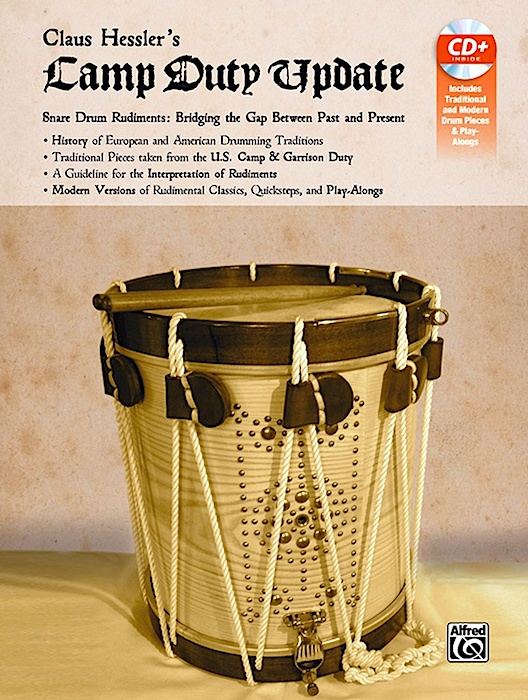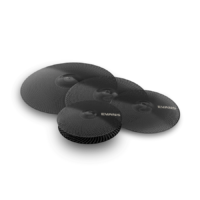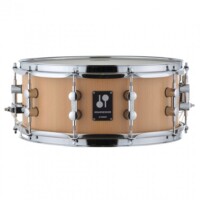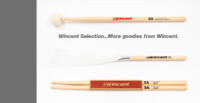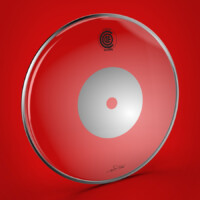 Trap Style Drumming – Gregory “Torch” Sgrulloni
Trap Style Drumming – Gregory “Torch” Sgrulloni
It’s one of those sounds that is now everywhere and a style of drumming that on the surface of it, seems pretty straight forward. As with most things though if you dig a little deeper, it opens a door to a whole bunch of new sounds and ideas.
After four forewords from Johnny Rabb, KJ Sawka, Jarrett Zellea and Adam Deitch, there’s a nice little introduction on what trap music and it’s history as well as where you can hear it. If you know what an 808 sounds like, you will have a decent idea already of where this book is headed.
Torch has done a great job of explaining some of the fundamentals of trap drumming in a really succinct way. Sound is key with any style and Torch has included some ideas and tips on snare tuning that you might find useful as well.
Now if electronic and hybrid drumming isn’t necessarily your bag I can understand that, but did you know that actually in trap music both the half time feel on the snare and 3:2 clave concepts are prominent? I hadn’t really thought about the first, and certainly hadn’t spotted the second.
Getting into the actual exercises and we begin with 3 over 2 polyrhythms, a fundamental element in trap style playing and something that may give you a minute or two mild amusement/frustration before they click.
Chapter Two looks at the concept of the hi hat and how the note values move in and out of groups of quavers, triplets and semi quavers etc before we get into a chapter I especially liked, which was about rhythmic fragments.
In this section you play on the snare and kick, under the hi hats. They’re not the most complicated of ideas, but the key, as always, is tightness and execution; and some of these will definitely need a little attention (especially when playing both snare and kick at the same time).
As the book progresses through the following chapters it gets more into the fragments including a “table of trap fragments”, much like any other rhythmic table but with suggestions and ideas on how to adapt and use them in a trap style.
The electronics is a huge part of trap drumming and so Chapter 9 is dedicated to the integration of electronics into a set up. Once again Ableton Live gets a big talk up, alongside examples of triggers, pads, samplers etc.
You can just jump into this book at any point and work on the ideas, but I think it’s best used as written, letting the ideas bed in and building on the previous chapter.
There is also a video download card for checking out the videos yourself and decent appendix, pointing you un the direction of trap music artists, producers and online resources.
A great book for anyone interesting in playing or writing trap music, well laid out and easy to get into.
Rob Crisp
Available from Hudson Music
Thomas Lang – ProgPop
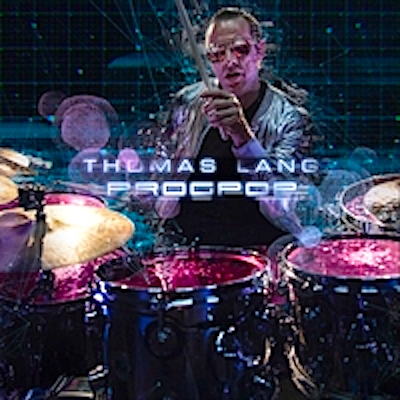 I’ve had this album on in the van for a few weeks now and first time I listened I couldn’t help but smile to myself.
I’ve had this album on in the van for a few weeks now and first time I listened I couldn’t help but smile to myself.
We all know Thomas, he has his fans and his critics, but the one thing we can all agree on is that Thomas can play things almost no one else on the planet can play and right here is just straight up Thomas Lang; amusing, over the top, brilliant.
If you need proof of this, one of the most catchy tunes is called Donkey, which features Freddie Nelson on vocals, a mean bit of guitar from Tobias Mertens, Kevin Chown on bass and a throbbing syncopated double bass drum groove, which then moves into a songo-esque cowbell break before a straight up rock chorus.
The thing is though, as much as I say this is Thomas having a laugh, it’s the perfect vehicle for him to do his thing; groove it out, play technical, go mad on the solo’s. This is a pop record around a prog rock and metal core, and although in my head they shouldn’t mix, Thomas has put them together anyway and actually, it does work.
There are a few moments I could almost hear the sounds of his youth coming through from the days of Falcoand Rock Me Amadeus. For me it has that same vibe; as in it’s fun, easy going, occasionally a bit silly but actually, if you take it for what it is then it’s great!
For the fans of Thomas’ technical playing, there are some great ideas here; odd times, polyrhythms, independence etc as you’d expect.
I spent a few minutes listening to the intro groove to I Don’t Know You Anymore and I still wouldn’t want to bet my life on having counted it correctly, and the main groove to Time is a full on masterclass of four way independence and multi pedal orchestrations. I now want octabans just (to attempt) to play this groove, it’s that catchy.
The lyrics I found to be quite thoughtful at times, posing interesting questions about what it is to know someone, or what’s really important in life… But in-between thinking about that, my train of thought was interrupted by some more unapologetic soling. And I liked it.
You can see a video play throughs on a certain video streaming site, but you should bag yourself a copy of the CD too, the cover is cool.
Rob Crisp
Available from iTunes and CD Baby
Claus Hessler’s Camp Duty Update
I’ve reviewed a lot of books over the years for MikeDolbear.com and by far this is one of the most interesting.
If you’re familiar with marching or military drumming you may have heard of the US Army’s Camp and Garrison Duty; essentially the pieces played on a marching drum to command the troops on the battlefield; back before wireless communication obviously. What Claus has done here is recreate some of these pieces to make them easier to read and added some new variations on the pieces; hence the “Update”.
Before you can get stuck into playing though there is a bit of background to absorb…
Claus has gone all the way back to the 14th Century and researched exactly where the discipline of playing a marching drum comes from and how it has evolved over the coming centuries until we reach the 21st, where we now have our nicely defined set of rudiments.
I found this entire section to be rather fascinating myself, I had no idea the Swiss were quite so influential in the spread of marching drums and rhythms and to be honest, although I could have told you that the rudiments came from marching drums and bands, I wouldn’t have been able to give you much more.
Certainly after reading the first pages of this book you’ll know a lot more about the history of our instrument. Teachers; you owe it to your students’ to read this!
When it comes to the traditional pieces from Camp Duty and so on, these are beautifully transcribed in the traditional notation, including written notes in German and other languages, before the updated versions in what looks much more like the notation we’re used to.
The CD is also excellent and Claus has recorded all the parts to enable you to play along. As I found, just being able to listen to the parts is very useful, allowing you to get your head around some of the more tricky ideas and phrases.
There is abundance of material here for anyone who’s into marching drum, or simply playing snare. If you’re simply looking for something a little different to get stuck in to, I’d give this a book a serious look.
As someone who “knows” his rudiments, I found this book to be educational, enjoyable and at the same time accessible. Claus has clearly put a great deal of time and effort into it in order to research the history and create something new from the traditional pieces.
Rob Crisp
Available from alfreduk.com

